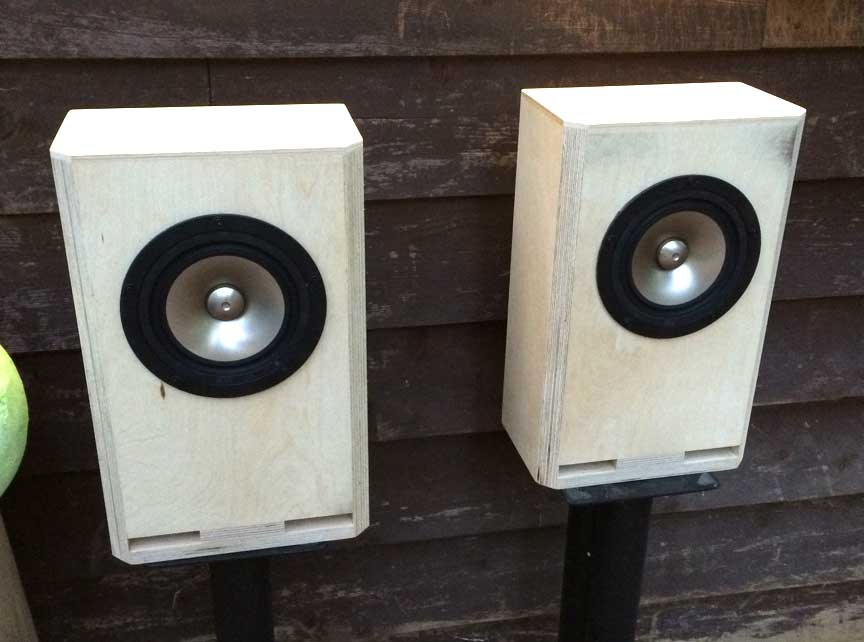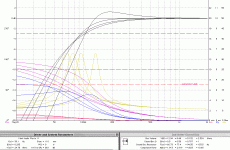It looks to me like it probably barely moves 2-3 mm before it starts rattling.
Is it possible you're underestimating the cone travel? How's about posting a short video from you phone.
jeff
@Dave.
This is from the product page.
"The Pluvia 11 is a completely new driver design. It is the first “full range” driver that can handle bass loads typically delivered by 5.5 inch to 6.5 inch mid-bass units used in most 2 way systems."
I understand we're talking about a full range driver and I can't expect subwoofer performances, but at least it should be better than the drivers you mentioned.
Also, my cabinet will be sealed, so higher area + higher travel should result in higher bass. The rest of the frequency range will be flattened out by DSP, so the rest of the spectrum response doesn't really matter.
@jeff
I just tried some low frequency test tones and I can hear noise when the travel is definitely below xmax. It almost sounds like clicks at first, then it turns into a buzz as frequency or volume increase. It's very weird.
This is from the product page.
"The Pluvia 11 is a completely new driver design. It is the first “full range” driver that can handle bass loads typically delivered by 5.5 inch to 6.5 inch mid-bass units used in most 2 way systems."
I understand we're talking about a full range driver and I can't expect subwoofer performances, but at least it should be better than the drivers you mentioned.
Also, my cabinet will be sealed, so higher area + higher travel should result in higher bass. The rest of the frequency range will be flattened out by DSP, so the rest of the spectrum response doesn't really matter.
@jeff
I just tried some low frequency test tones and I can hear noise when the travel is definitely below xmax. It almost sounds like clicks at first, then it turns into a buzz as frequency or volume increase. It's very weird.
Dave, I'm not saying that with those specific cabinets you get worse bass response from the P11 compared to the other drivers. It very well might be (maybe a cabinet specifically optimized for the P11 could give you better bass? I don't see any reason why it wouldn't, but I digress).
What I'm saying is that higher area and excursion equals more bass, provided that the cabinet lets the drive to its job.
But right now I'm more concerned about the noise of the driver itself, way before it reaches 7.5 mm xmax.
Once that is fixed (hopefully), I can worry about designing a cabinet that allows the driver to move that much.
What I'm saying is that higher area and excursion equals more bass, provided that the cabinet lets the drive to its job.
But right now I'm more concerned about the noise of the driver itself, way before it reaches 7.5 mm xmax.
Once that is fixed (hopefully), I can worry about designing a cabinet that allows the driver to move that much.
To see about the noise you need to contact Madisound (or maybe Mark Audio directly).
The small CGR is very specific to the P11, the FHXL is not but extracts more bass from it.
Excursion and cone area determine how much volume of air can be moved but not how low a driver can go.
dave
The small CGR is very specific to the P11, the FHXL is not but extracts more bass from it.
Excursion and cone area determine how much volume of air can be moved but not how low a driver can go.
dave
I contacted Madisound. We'll see what they say..
Are you talking about the fact that cabinet design can affect the impedance at certain frequencies so that the driver is not able to move as much in respect to other frequencies, if that is not addressed in some other way?
What I meant to say is that, provided that in each respective box (of closed type), two separate drivers are able to move up to their xmax at a certain frequency, the driver with higher area/xmax will produce more SPL at that frequency.
Are you talking about the fact that cabinet design can affect the impedance at certain frequencies so that the driver is not able to move as much in respect to other frequencies, if that is not addressed in some other way?
What I meant to say is that, provided that in each respective box (of closed type), two separate drivers are able to move up to their xmax at a certain frequency, the driver with higher area/xmax will produce more SPL at that frequency.
What I meant to say is that, provided that in each respective box (of closed type), two separate drivers are able to move up to their xmax at a certain frequency, the driver with higher area/xmax will produce more SPL at that frequency.
That is true but it says noting about how low that frequency can be. That is determined more by Fs and Qt.
dave
That is true but it says noting about how low that frequency can be. That is determined more by Fs and Qt.
dave
... Though he was talking about EQing it.
In which case, displacement rules so long as you're happy with the sacrifices to get there.
Chris
If you are EQing below the box resonant frequency you are putting a lot more strain on the driver than when the driver/box reaches that low itself… something like the EQed driver needs 4 x the excursion.
dave
Depends how low you're EQing it.
A driver in a sealed box needs a fixed amount of excursion to produce a given SPL at a given frequency. If the box is tiny, it'll be inefficient at LF and need more power to make the excursion happen.
Going an octave down at the same SPL requires 4x the excursion to maintain SPL.
It's more power being dumped into the driver, and likely more excursion being used (certainly compared to a tuned alignment), but if the end user is happy with that compromise (ie, reduced headroom available) then I don't see any problem. For 70 or 80dB peaks on a desk, you could probably EQ flat down to 40Hz and rarely see the cone move.
Just checked - a pair of drivers producing 40Hz in a sealed box would need 1.3mm one-way excursion to hit 80dB, and that's groundplane.
Chris
(Off topic) By the way, Chris, any update on your binaural microphone?
Very good question. Not yet. I've had a busy Summer with lots of gigs, but Winter is here and they're starting to slow down so I do plan on getting back to that.
Glad we're on the same page with regards to EQing a sealed box.
Chris
I took this video were you can hear the noise.
Dropbox - Pluvia 11 test.mp4
A 40 Hz sine wave is playing. I slowly bring down the paper ruler (which shows 7 mm, for reference) until the cone dust cap barely touches it.
Once that happens, I stop the signal. That way, one can see that the cone travel is way less than 7.5 mm.
Anyone of you guys can try this on their Pluvia 11s?
Dropbox - Pluvia 11 test.mp4
A 40 Hz sine wave is playing. I slowly bring down the paper ruler (which shows 7 mm, for reference) until the cone dust cap barely touches it.
Once that happens, I stop the signal. That way, one can see that the cone travel is way less than 7.5 mm.
Anyone of you guys can try this on their Pluvia 11s?
Thank you, Dave. Would it be possible for you to test one of them in free air?
I found out that a 50 Hz pure sine wave signal test would be best (or worst, depending on the point of view). For whatever reason my P11s don't seems to like that at all. The buzzing is nasty at less than 2 mm travel, at that frequency.
I found out that a 50 Hz pure sine wave signal test would be best (or worst, depending on the point of view). For whatever reason my P11s don't seems to like that at all. The buzzing is nasty at less than 2 mm travel, at that frequency.
One is going to get the most motion at resonance, specced at 40 Hz.
dave
That just means that I need less power to make it move by a certain travel distance x peak to peak, compared to other frequencies.
But there shouldn't be any buzzing as long as the travel is kept under x-max, no matter the frequency.
Anyway, at 40 Hz the buzz is definitely there. It just is a lot worse at 50 Hz.
I didn't test higher frequencies though.
- Status
- This old topic is closed. If you want to reopen this topic, contact a moderator using the "Report Post" button.
- Home
- Loudspeakers
- Full Range
- Markaudio Pluvia Eleven

